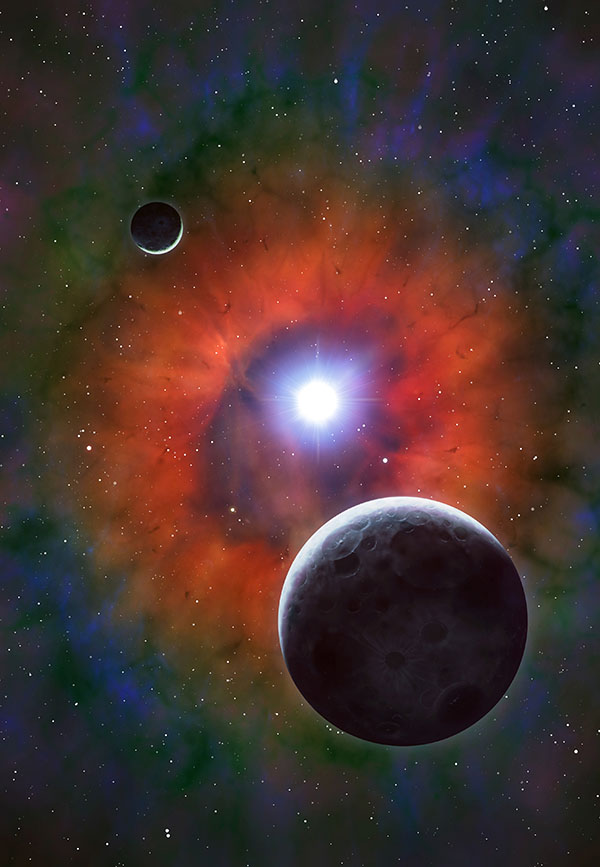Astronomers Make First Measurement of Phosphorus “Starstuff” Created in a Supernova

Artist’s rendering of a super-massive star and two of its planets as the star becomes a supernova, the remnant of which we see today as Cas A. Image credit: Dr. Mark A. Garlick; Dunlap Institute for Astronomy & Astrophysics, U of T
An international team of astronomers, including Prof. Dae-Sik Moon at the University of Toronto, has measured for the first time the abundance of phosphorus created in a supernova explosion.
The team’s observational results show that phosphorus is 100 times more abundant in the remains left over from a supernova than elsewhere in the galaxy, confirming that massive exploding stars are the crucibles in which the element is created.
Astronomers have measured the abundance of carbon, nitrogen, oxygen, and sulphur in supernovae remnants before. But this is the first measurement of the relatively scarce phosphorus.
“These five elements are essential to life and can only be created in massive stars,” says Moon, co-author of the paper being published in the journal Science on December 13, 2013.
“They are scattered throughout our galaxy when the star explodes, and they become part of other stars, planets and ultimately, humans,” says Moon. “This is why Carl Sagan said we are made of ‘starstuff’. Now we have measured how much of this particular element of starstuff is created in supernovae.”
Moon is in the Department of Astronomy & Astrophysics and the Dunlap Institute for Astronomy & Astrophysics at the U of T. Other members of the research team include lead author Bon-Chul Koo, Yong Hyun Lee and Sung-Chul Yoon of Seoul National University in Korea, and John Raymond of the Harvard-Smithsonian Center for Astrophysics.
The observations were of the remnant of a supernova believed to have been observed over 300 years ago. Called Cassiopeia A (Cas A), it lies at a distance of about 11,000 light-years.

Three-color composite image of the young supernova remnant Cas A. Image credit: Bon-Chul Koo, Young-Hyun Lee (Seoul National University), Dae-Sik Moon (University of Toronto), NASA
Astronomers believe the original star was between 15 and 25 times the mass of the Sun. When a star of such mass runs out of the hydrogen that it burns to produce energy, the core of the star goes through a sequence of collapses, synthesizing heavier elements with each collapse.
Moon and his colleagues made their observations using the TripleSpec near-infrared spectrograph on the Palomar 5-metre Hale telescope. The instrument—which Moon co-developed—allowed the team to directly compare the spectral lines of phosphorus and iron and, thus, calculate the abundance ratio of the two.
Carl Sagan knew that this starstuff is the “…the calcium in our teeth, the iron in our blood.” Now, Moon and his colleagues have directly measured the starstuff that is the phosphorus in our DNA and our bones.
-30-
CONTACT INFORMATION:
Prof. Dae-Sik Moon
Department of Astronomy & Astrophysics
Dunlap Institute for Astronomy & Astrophysics
University of Toronto
e: moon@astro.utoronto.ca
p: 416-978-6566
http://www.astro.utoronto.ca/~moon
Chris Sasaki
Public Information Officer
Dunlap Institute for Astronomy & Astrophysics
University of Toronto
e: csasaki@dunlap.utoronto.ca
p: 416-978-6613
The Dunlap Institute for Astronomy & Astrophysics, University of Toronto, continues the legacy of the David Dunlap Observatory: by developing innovative astronomical instrumentation, including for the largest, most advanced telescopes in the world; by training the next generation of astronomers; and by fostering public engagement in science. The research of its faculty and postdoctoral fellows includes the discovery of exoplanets, the formation of stars, galactic nuclei, the evolution and nature of galaxies, the early Universe and the Cosmic Microwave Background, and the Search for Extra-terrestrial Intelligence (SETI).
###
